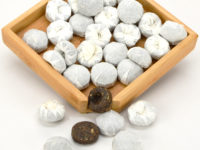Bi Tan Piao Xue (Snow Drop Jasmine)
Scented Tea 2025
An early spring green tea made from a rich-flavored Sichuan tea cultivar. Scented multiple times with fresh jasmine buds for a rich long floral finish that lasts through many infusions. Produces beautiful visuals, with jasmine petals resembling snowflakes on a green pond.
2025’s Snow Drop Jasmine delivers constant warm soft jasmine accompanied by classic dewy green tea vegetal complexity.
- Tea Origin
- Mengding Mountain, Ya'an City, Sichuan Province, China; Jasmine from Sichuan Province
- Tea Bush
- Dabai (Big White), Mingshan #131
- Tea Maker
- Luo Ping
- Harvest Time
- Late March (tea), June (jasmine)
- Plucking Standard
- One bud, two leaves
The full name of this famous Chinese tea is “Bi Tan Piao Xue” or “Snow Drop in Emerald Pond.” When this jasmine green tea is brewed, the tea buds fall to the bottom while the white jasmine petals float on the surface of the glowing green water. This vision resembles snowflakes falling into an emerald pool. Snow Drop jasmine was invented by an anonymous tea master who traveled to a famous scenic location, Jiu Zhai Gou. There are incredibly picturesque landscapes in this area with clear flowing rivers. When the tea maker traveled there, it was the middle of winter. The scene of big snow flakes dropping on top of the ponds and flowing rivers gave him an idea. He decided to recreate this scene with white jasmine flowers floating above a delicate green tea that would color the water a pure and transparent green, just like the ponds he saw.
For this tea, we’ve used tea leaves from the famous Sichuan tea region, specifically, Mengding Mountain. This region is believed to be one of the first places humans began to cultivate tea. There are also a great number of tribute teas from this region. The high end green tea is finished at the end of March and stored for later scenting when the jasmine flowers bloom in May.
This tea is produced from high-quality, early spring tea buds and the highest-quality, most delicate jasmine flower buds to create a fresh flavor and lingering aroma over several infusions. The quality of this tea allows you to use less tea and short infusion times to fully appreciate the flavor and aroma, however the high quality also limits the amount of production available per picking season.
Making Traditional Jasmine Scented Tea

For the scenting of high-end tea, the tea masters will use a ratio of 60% tea leaves to 40% jasmine flowers. Lower grades will use less flowers and more tea. The jasmine flowers are picked in the morning and brought back to the factory immediately. Tea makers will place approximately 5 cm of tea leaves below a layer of jasmine, followed by 5 cm layer of tea and another layer of jasmine. They continue this stacked layering until the pile is about half a foot tall. After about 5 hours, they mix the tea and jasmine together.
Fresh jasmine flowers create heat as they oxidize, and in order to evenly disperse the heat and distribute their scent, the leaves and flowers must be stirred. The mixture will sit for another 5-6 hours, depending on the humidity that day. After a sufficient amount of time, tea makers use a special machine to sort out all of the jasmine flowers from the tea.

The tea quickly gets re-roasted to remove any water it has absorbed from the flowers during the mixing. The tea is then set aside for 2-3 days to absorb the jasmine aroma. After a few days pass, they will repeat the whole scenting process, but pile the leaves and flowers higher. This process is repeated 5 times for high-end teas, taking about 2-3 weeks in total. At the end of the last piling process, the tea makers must roast the tea one final time to make it stable for shelving by reducing their water content to about 5 percent.
High-end jasmine teas must be completely separated from the jasmine flowers after each scenting process. For the flowers that are included in the final tea, tea makers use a different batch of jasmine flower petals that have been dried quickly to prevent them from yellowing. The delicate white jasmine petals are only used for decoration; they are not involved in the scenting process.
The “Tiger’s Palm” Stage of Jasmine Flowers

The jasmine flowers used for scenting tea are neither completely opened nor are they small buds. The buds must be harvested just as they are about to open. This stage is what the Chinese refer to as “tiger’s palm.” It is during this stage that the jasmine flower will have the richest aroma and the scent will last the longest, for about 9-12 hours after picking.
No chemical fertilizer, pesticide, or herbicide was used in the production of this tea. Click here to read more about our promise to fair trade and the environment.














